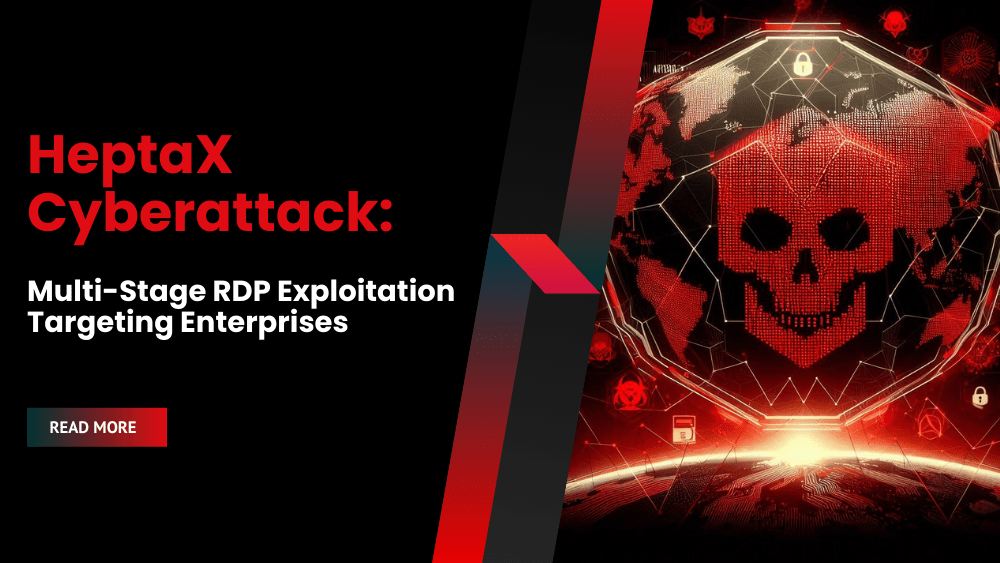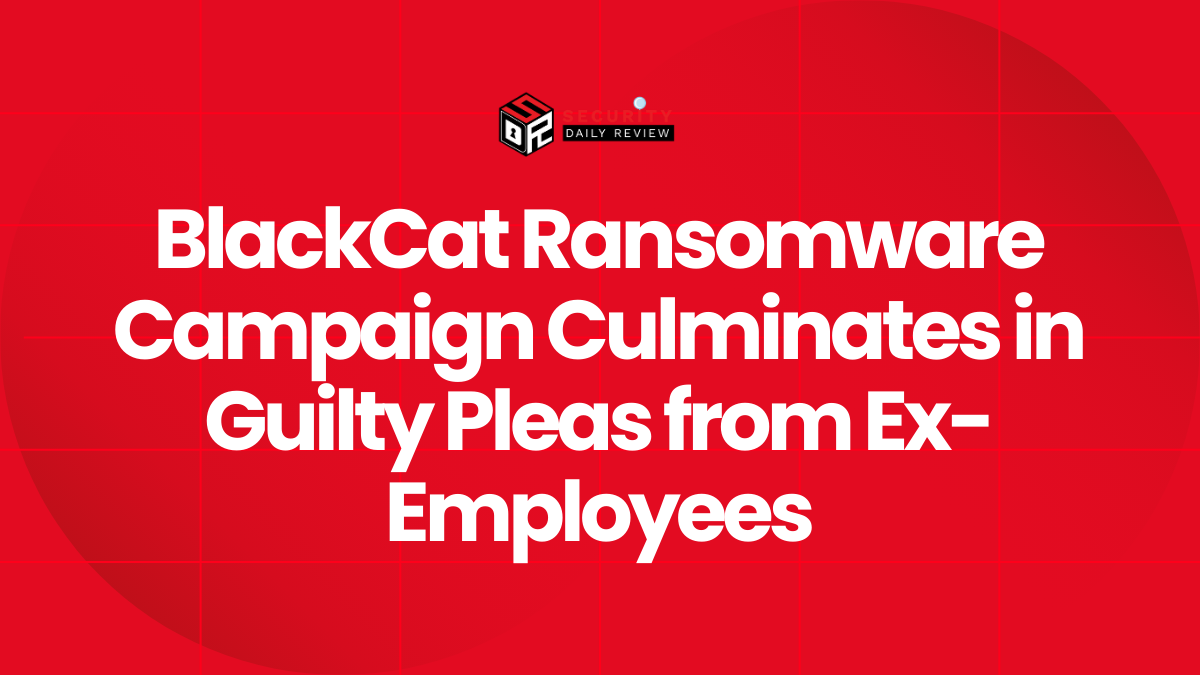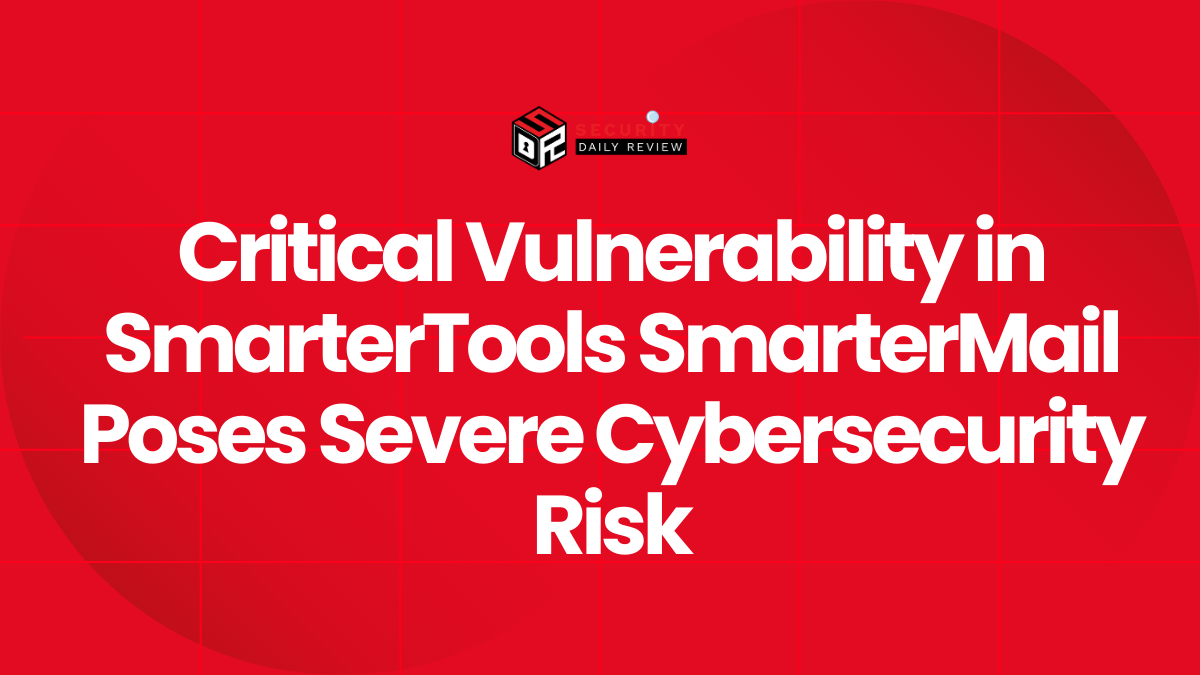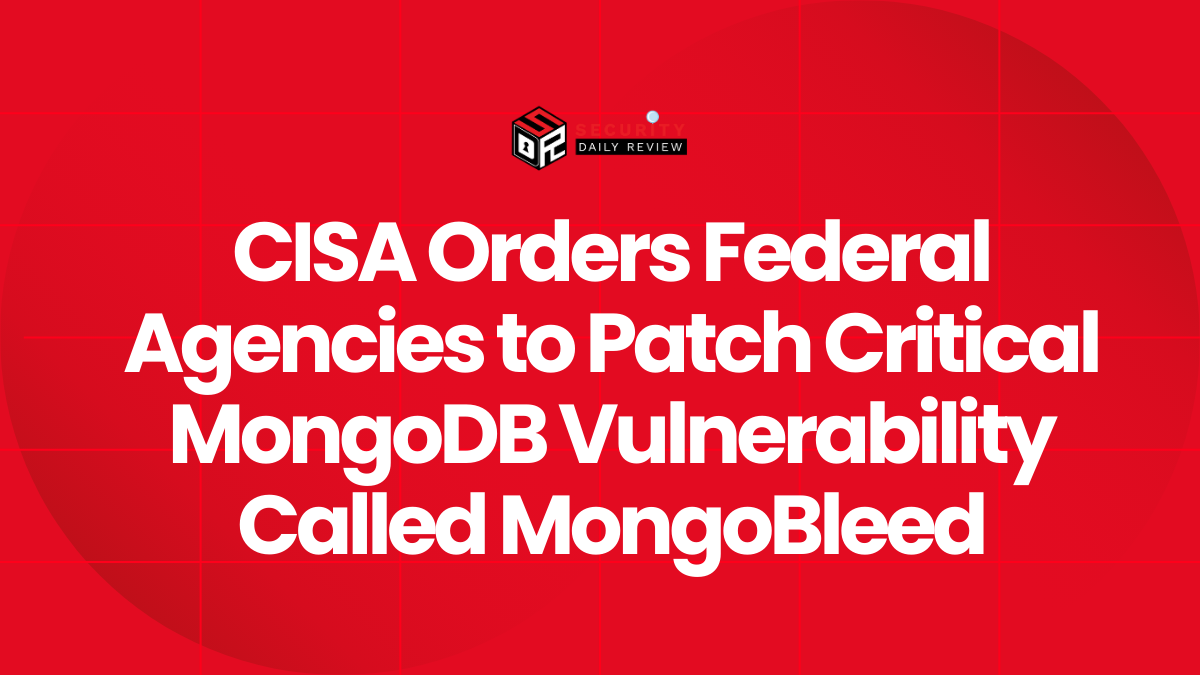Cyble Research and Intelligence Labs (CRIL) uncovered a concerning cyberespionage campaign dubbed “HeptaX.” This sophisticated attack leverages malicious LNK files and PowerShell scripts to gain unauthorized access to Remote Desktop Protocol (RDP) systems, posing significant risks to enterprise businesses, especially those in the healthcare sector. This detailed analysis explores the HeptaX cyberattack, its technical intricacies, and the critical steps organizations can take to mitigate the threat.
Understanding the HeptaX Threat
The HeptaX campaign showcases a multi-layered approach to cyber espionage.
The attack begins with a seemingly innocuous ZIP file containing a malicious LNK (shortcut) file.

HeptaX campaign infection chain (Source: Cyble)
While the exact distribution method remains unconfirmed, strong suspicion points towards phishing emails targeting the healthcare industry. This targeted approach highlights the attackers’ focus on specific sectors with potentially valuable data.
The initial infection vector is the malicious LNK file. Upon execution, this file triggers a PowerShell command that initiates a chain reaction:
- Payload Download: The PowerShell command downloads additional payloads from a remote server. These payloads include further PowerShell scripts and BAT files, demonstrating the attackers’ preference for script-based techniques to evade traditional security measures.
- Administrative Account Creation: A critical step is the creation of a new administrative user account on the compromised system. This account, often named “BootUEFI,” significantly simplifies subsequent access and control for the attackers. The creation of this account highlights a key objective – establishing persistent, privileged access.
- RDP Configuration Modification: The attackers modify the Terminal Services (RDP) settings to lower authentication requirements. This makes it significantly easier for them to establish unauthorized remote access to the victim’s system. This step is crucial because it bypasses standard security protocols and provides easy access for the attacker.
Technical Analysis of the HeptaX Attack Chain
The HeptaX campaign relies heavily on PowerShell and Batch scripts, providing the attackers with significant control over compromised systems. The initial PowerShell script constructs a base URL to manage communication and download subsequent payloads. This approach reflects a growing trend in cyberespionage, where attackers favor script-based methods to avoid detection by traditional security solutions.
A key aspect of the attack is the generation of a unique identifier (UID) for each compromised system. This UID, obtained from specific registry paths or generated if none exists, likely serves to track individual victims and manage the attack campaign effectively. The UID creation enhances the attackers’ ability to track their progress and manage the compromised systems effectively.

UID Generation (Source: Cyble)
The attack progresses through several distinct stages:
- Initial Compromise: The attack begins with a phishing email containing a ZIP file with a malicious LNK file. This is a classic social engineering tactic.
- PowerShell Execution: Executing the LNK file triggers a PowerShell command that downloads further payloads, including scripts for persistence and privilege escalation.
- UAC Manipulation: The script assesses and modifies User Account Control (UAC) settings to lower security measures, making it easier for the attackers to execute malicious code.
- Batch File Deployment: Multiple BAT files are downloaded and executed, facilitating the creation of the administrative account and the modification of RDP settings for unauthorized access.
- Final Payload Execution: A final PowerShell script performs reconnaissance, gathering sensitive information, including user credentials and network configurations. This final stage is crucial for data exfiltration and further system compromise.
This attack aligns with several MITRE ATT&CK techniques and tactics:
- Techniques: T1082 (System Information Discovery), T1140 (Deobfuscate/Decode Files or Information), T1486 (Data from Local System), T1083 (System Network Configuration Discovery), T1105 (Ingress Tool Transfer).
- Tactics: TA505 (Initial Access), TA0011 (Credential Access), TA0001 (Command and Control), TA0002 (Execution), TA0005 (Privilege Escalation).
HeptaX Indicators of Compromise (IOCs)
The following IOCs were associated with the HeptaX campaign:
- a31f222fc283227f5e7988d1ad9c0aecd66d58bb7b4d8518ae23e110308dbf91
- 7bdbd180c081fa63ca94f9c22c457376
- c67b03c0a91eaefffd2f2c79b5c26a2648b8d3c19a22cadf35453455ff08ead0
- 8c69830a50fb85d8a794fa46643493b2
- bbcf7a68f4164a9f5f5cb2d9f30d9790
These hashes represent malicious files or network activity associated with the attack. Security professionals should use these IOCs to detect and prevent similar attacks.
Vulnerabilities HeptaX Exploits (CVEs)
While the specific vulnerabilities exploited in the HeptaX campaign aren’t explicitly detailed, the provided CVEs offer potential insights:
- CVE-2024-21887, CVE-2024-21893: (Requires research to determine relevance to the attack)
- CVE-2023-46805: (Requires research to determine relevance to the attack)
- CVE-2017-11882: (Requires research to determine relevance to the attack)
- CVE-2021-44228: (Log4j vulnerability – research needed to determine if exploited indirectly)
Further research is needed to determine the precise role of these CVEs in the HeptaX attack.
HeptaX Threat Actors, Malware, and Sources: A Deeper Dive
The initial report mentions several threat actors, malware families, and sources, providing valuable context but not definitive attribution to the HeptaX attack. Let’s examine each category in more detail:
Threat Actors: Potential Players in the Cyber Espionage Landscape
The list included names like Lockbit, Blackcat, Lazarus, VoltTyphoon, and Kimsuky. These are all well-known and highly active threat actors, each with distinct characteristics and operational methods:
- Lockbit: Known for its ransomware-as-a-service (RaaS) operations, Lockbit is notorious for its data extortion tactics. While primarily focused on ransomware, their capabilities extend to data exfiltration and other malicious activities. Their involvement in HeptaX is unlikely given the focus on espionage, but it’s important to note their presence in the broader threat landscape.
- Blackcat (ALPHV): Another RaaS group, Blackcat is known for its sophisticated techniques and rapid encryption capabilities. Similar to Lockbit, their primary focus is ransomware, making their direct involvement in HeptaX less probable.
- Lazarus Group: This North Korean state-sponsored group is known for its advanced persistent threats (APTs) and sophisticated cyber espionage operations. Their operations often involve targeting financial institutions and governments, making them a plausible, though unconfirmed, candidate for the HeptaX attack. Their capabilities align with the complexity of the HeptaX campaign.
- Volt Typhoon: This China-linked APT group is known for its long-term, persistent attacks targeting critical infrastructure. Their focus on infrastructure makes them a less likely candidate for the HeptaX attack, which appears to be more focused on data exfiltration.
- Kimsuky: This North Korean APT group is known for its sophisticated cyber espionage operations targeting various sectors, including government, defense, and research. Like Lazarus, Kimsuky’s capabilities align with the complexity of the HeptaX attack, making them a plausible, albeit unconfirmed, suspect.
Malware Families: Tools of the Trade
The mentioned malware families – Cobalt Strike, Qakbot, Icedid, Trickbot, and Xmrig – are commonly used by various threat actors for different purposes:
- Cobalt Strike: A legitimate penetration testing tool often misused by attackers for command and control (C2) infrastructure, lateral movement, and post-exploitation activities. Its use in the HeptaX attack is highly plausible, given its capabilities.
- Qakbot (Qbot): An information-stealing trojan that can download and execute additional malware. Its presence would likely precede other malicious activities in the attack chain.
- Icedid (Bokbot): Another information-stealing trojan known for its ability to spread rapidly and download additional malware. Similar to Qakbot, its presence would suggest an early stage in the attack.
- Trickbot: A banking trojan capable of stealing financial information and credentials. While not directly related to espionage, it could have been used to gather credentials that could aid in further compromise.
- Xmrig: A cryptocurrency miner that could be used to generate revenue for the attackers or as a distraction tactic. Its presence is less likely to be central to the espionage aspects of the HeptaX attack.
Consequences of a Successful HeptaX Compromise and Attacker Tools
Once the attackers have established a foothold through the “BootUEFI” account and modified RDP settings, they gain extensive control over the compromised system. This access enables a range of malicious activities, posing significant risks to enterprise businesses:
- Malware Installation: With unrestricted access, attackers can easily install additional malware to enhance their control, potentially deploying ransomware, data stealers, or backdoors for persistent access. This allows for further compromise and exfiltration of sensitive data.
- Data Exfiltration: Sensitive information, including intellectual property, customer data, financial records, and healthcare records (in the case of targeted healthcare organizations), can be easily stolen. The consequences of data breaches can be devastating, leading to financial losses, reputational damage, and legal liabilities.
- User Activity Monitoring: Attackers can monitor user actions, gaining insights into organizational processes and potentially sensitive information. This allows attackers to understand the organization’s operations and target valuable assets more effectively.
- System Manipulation: Attackers can alter system settings to further entrench their presence or create backdoors for future access. This allows for long-term access and control of the compromised systems.
A crucial tool used in the HeptaX campaign is ChromePass, a well-known password recovery tool. This tool harvests saved passwords from Chromium-based browsers, significantly increasing the potential for broader account compromises. The use of ChromePass highlights the attackers’ intent to gain access to numerous accounts beyond the initial compromised system. This could lead to access to email, cloud services, and other sensitive accounts.
HeptaX Mitigation Strategies for Enterprise Businesses
Protecting against the HeptaX cyberattack and similar threats requires a multi-layered approach focused on prevention, detection, and response. Enterprise businesses should implement the following strategies:
- Robust Email Security: Implement advanced email filtering and anti-phishing solutions to block malicious attachments and links. Employee training on recognizing phishing emails is also crucial.
- Restrict Script Execution: Limit the execution of PowerShell and other scripting languages to authorized users and processes. This can significantly reduce the impact of script-based attacks.
- Principle of Least Privilege: Enforce the principle of least privilege, granting users only the necessary access rights to perform their jobs. This limits the potential damage from compromised accounts.
- Strong Password Policies: Implement and enforce strong password policies, requiring complex passwords and regular changes. Consider using password managers to help employees manage strong, unique passwords.
- Multi-Factor Authentication (MFA): Enable MFA for all accounts, especially those with privileged access. MFA adds an extra layer of security, making it significantly harder for attackers to gain access even if they have stolen credentials.
- Regular Security Audits and Penetration Testing: Conduct regular security audits and penetration testing to identify vulnerabilities and weaknesses in your systems. This proactive approach helps identify and address potential attack vectors before they can be exploited.
- Network Monitoring and Intrusion Detection: Implement comprehensive network monitoring and intrusion detection systems to detect unusual activities and potential attacks. This allows for early detection and response to security incidents.
- Regular Software Updates and Patching: Keep all software and operating systems updated with the latest security patches. This addresses known vulnerabilities that attackers could exploit.
- Endpoint Detection and Response (EDR): Deploy EDR solutions to monitor endpoint activity and detect malicious behavior. EDR solutions provide real-time visibility into endpoint activity, enabling faster detection and response to threats.
- Security Awareness Training: Provide regular security awareness training to employees to educate them about phishing scams, social engineering tactics, and other cybersecurity threats. This helps employees recognize and avoid potential attacks.
Conclusion
The HeptaX cyberattack highlights the increasing sophistication of cyber espionage campaigns targeting enterprise businesses. The reliance on readily available tools and techniques, combined with a focus on exploiting RDP vulnerabilities, underscores the need for proactive security measures. By implementing a comprehensive security strategy that incorporates the mitigation strategies outlined above, organizations can significantly reduce their risk of falling victim to similar attacks and protect their valuable data and systems. Regularly reviewing and updating your security posture is crucial in the face of constantly evolving threats.
FAQs:
Q: What is the HeptaX cyberattack?
A: The HeptaX cyberattack is a sophisticated multi-stage campaign that uses malicious LNK files and PowerShell scripts to gain unauthorized RDP access, primarily targeting enterprise businesses, particularly in the healthcare sector, to steal sensitive data.
Q: How does the HeptaX cyberattack work?
A: The HeptaX attack begins with a phishing email containing a malicious LNK file. Upon execution, this file triggers a chain of events, including downloading additional payloads, creating an administrative account (“BootUEFI”), modifying RDP settings, and using tools like ChromePass to steal credentials.
Q: How can my enterprise protect itself from the HeptaX cyberattack?
A: Implement robust email security, restrict script execution, enforce strong password policies, enable MFA, conduct regular security audits, utilize network monitoring, deploy EDR solutions, and provide comprehensive security awareness training to employees. Staying up-to-date with security patches is also crucial.









